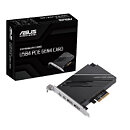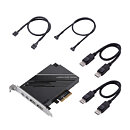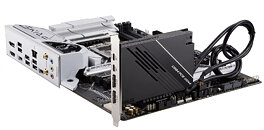TheLostSwede
News Editor
- Joined
- Nov 11, 2004
- Messages
- 18,472 (2.47/day)
- Location
- Sweden
| System Name | Overlord Mk MLI |
|---|---|
| Processor | AMD Ryzen 7 7800X3D |
| Motherboard | Gigabyte X670E Aorus Master |
| Cooling | Noctua NH-D15 SE with offsets |
| Memory | 32GB Team T-Create Expert DDR5 6000 MHz @ CL30-34-34-68 |
| Video Card(s) | Gainward GeForce RTX 4080 Phantom GS |
| Storage | 1TB Solidigm P44 Pro, 2 TB Corsair MP600 Pro, 2TB Kingston KC3000 |
| Display(s) | Acer XV272K LVbmiipruzx 4K@160Hz |
| Case | Fractal Design Torrent Compact |
| Audio Device(s) | Corsair Virtuoso SE |
| Power Supply | be quiet! Pure Power 12 M 850 W |
| Mouse | Logitech G502 Lightspeed |
| Keyboard | Corsair K70 Max |
| Software | Windows 10 Pro |
| Benchmark Scores | https://valid.x86.fr/yfsd9w |
Back at Computex last year we got a look at the first USB4 add-in card, which was from MSI. Some six months later, ASUS has finally revealed its USB4 add-in card that simply goes by the name of USB4 PCIe Gen4 Card. The general design of the two cards appear to be more or less identical, at least in terms of outputs and inputs. As such, both cards feature two USB4 outputs and two DP 1.4 inputs for those that want to use the USB4 ports to connect to a display. Other inputs include a USB 2.0 header, a custom USB4 header for communication with the motherboard—similar to Thunderbolt add-in cards—and a 6-pin graphics card type power input. The card supports up to two monitors and three devices or one monitor and four devices when daisy chained.
ASUS has gone for a shroud on its card, so it's impossible to make out any real details, but based on the manual, ASUS has installed a heatsink on the ASM4242 USB4 host controller from ASMedia, albeit a smaller one than MSI. However, ASUS has only gone for 60 W USB Power Delivery compared to 100 W for the MSI card. If this makes any useful difference in a desktop PC is up for discussion though and would depend on specific use cases. On the other hand, ASUS allows for 60 W through both ports, whereas MSI only delivers 27 W through its secondary port. The card should work with any ASUS motherboard that has a TB/USB4 header. As ASUS has only just put up the product page, there's no word on pricing.




View at TechPowerUp Main Site | Source
ASUS has gone for a shroud on its card, so it's impossible to make out any real details, but based on the manual, ASUS has installed a heatsink on the ASM4242 USB4 host controller from ASMedia, albeit a smaller one than MSI. However, ASUS has only gone for 60 W USB Power Delivery compared to 100 W for the MSI card. If this makes any useful difference in a desktop PC is up for discussion though and would depend on specific use cases. On the other hand, ASUS allows for 60 W through both ports, whereas MSI only delivers 27 W through its secondary port. The card should work with any ASUS motherboard that has a TB/USB4 header. As ASUS has only just put up the product page, there's no word on pricing.




View at TechPowerUp Main Site | Source








